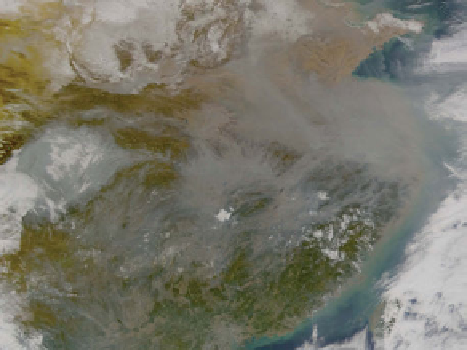Geoscience Reference
In-Depth Information
On September 1, 2000, China amended its Air Pollu-
tion Control Law again. The new law aimed to reduce
sulfur dioxide emissions from 16.9 million tonnes in
1999 to 9.1 million tonnes by 2010. It also required the
phase-out of dirty coal and provided incentives for the
use of low-sulfur, low-ash coal in medium and large
cities. New and expanded power plants in these cities
were required to install equipment that reduced sulfur
dioxide and aerosol particle emissions. Under the pre-
vious law, power plant emitters were fined only if their
emissions exceeded a certain standard. Under the new
law, emitters were fined on the basis of their total emis-
sions. In provinces where pollution standards were not
met, provincial governments could require all factories
in a given zone of the province to obtain an emission
permit.
Under the 2000 law, cities were given incentives to
replace coal heating stoves in households with central-
ized heating. All new coal-burning heating boilers were
banned from areas in which centralized heating was
available. Restaurants in large- and medium-size cities
were required to convert from coal to natural gas, liq-
uefied petroleum gas, or electricity. Household cooking
stoves were required to be converted from coal to gas,
electricity, or coal briquettes. Construction companies
were required to reduce resuspended dust emissions.
Cities were given incentives to pave or grow plants
over bare soil and reduce road dust.
Under the 2000 law, only emissions from industrial
sources and power plants were controlled; under the
new law, emissions from vehicles, ships, domestic heat-
ing and cooking, and construction were also controlled.
Passenger vehicle emission standards for year 2000
vehicles were set to Euro 1 standards (Table 8.5). Exist-
ing vehicles were required to be retrofitted to meet the
standards and pass annual emission checks and random
inspections. In 2004, emission standards were tightened
to meet Euro 2 standards. In 2007, they were tightened
further to meet Euro 3 standards and, in 2010, to meet
Euro 4 standards.
In 1998, China had seven of the ten most polluted
cities in the world. The government, itself, found that
two-thirds of 338 cities in which the air was moni-
tored were polluted. Despite significant efforts to con-
trol emissions through regulation, 16 of the world's 20
most polluted cities in 2006 were in China (Worldwatch
Institute, 2006) (e.g., Figure 8.11). The most polluted
city among these may be
Linfen, China
,acity of 3
million in the midst of China's coal mining region. The
air is so polluted on many days that laundry turns black
before drying. Birth defects are nearly thirty times the
Figure 8.10.
Satellite image of the Asian Brown Cloud
over central eastern China. The brown in the cloud is
due to a mix of absorbing aerosol particles and
nitrogen dioxide gas from vehicles, factories, and
power plants, as well as from wood burning for home
heating and cooking. Courtesy NASA/GeoEye, Inc.
NASA/GeoEye, Inc., http://eoimages.gsfc.nasa.gov/
ve/12878/china_shanghai.tif.
pollutants common in China are sulfur dioxide and
aerosol particles, both emitted during coal burning.
China, the world's largest producer and consumer of
coal, has the third largest coal reserves (after the United
States and Russia). Large sources of pollution in China
are industrial boilers and furnaces and residential burn-
ing of coal and solid biofuels for home heating and
cooking. Northern China also experiences severe
dust
storms
originating from the
Gobi Desert
.Inthespring
of 2000, the storms were the most severe in 50 years,
darkening the skies over northern China and large cities,
such as Beijing, more than twelve times. The intensity
and frequency of the dust storms were enhanced by soil
erosion and deforestation, coupled with drought. Pollu-
tion from China's cities, along with dust from the Gobi
Desert, are sources that affect local residents and are
also transported by the westerly winds to Japan, South
Korea, and across the Pacific to North America. The
pollution in China is so widespread and thick that it can
be seen in satellite images (Figure 8.10), comprising
part of the Asian Brown Cloud.
In 1995, China amended its
Air Pollution Control
Law of 1987
, calling for the phase-out of leaded gaso-
line by 2000. On July 1, 2000, sulfur and alkene con-
tents of gasoline in Beijing, Shanghai, and Guangzhou
were limited to 0.08 and 35 percent, respectively. These
limits applied to the rest of China in 2003.


Search WWH ::

Custom Search